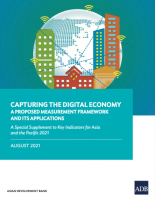
Moving government systems to the cloud can help future-proof public service. Photo credit: ADB.
With its potential to save billions for governments, moving public services to the cloud is one way for countries to digitally transform.
With countries across Asia and the Pacific still grappling with the coronavirus disease (COVID-19) pandemic, governments have adopted digital technologies to cope with the challenges of the new normal.
With its potential to save billions for governments, moving public services to the cloud is one way for countries to digitally transform. A new paper from the Asian Development Bank (ADB), Cloud Computing as a Key Enabler for Digital Government across Asia and the Pacific, says moving government systems to the cloud can help future-proof public service.
Policy recommendations
Here are four ways governments can benefit from cloud computing.
1. Reduce costs associated with upgrades of legacy technologies. Instead of investing in data centers and servers with limited advance knowledge of their eventual usage, cloud can allow governments to only pay for computing resources that are consumed. Adoption also requires only one technology migration onto the cloud, which ultimately streamlines the cost of government technology operations and improves overall efficiencies in deploying technology resources.
In Singapore, the Land Transport Authority saw cost savings of 60% when it migrated its web hosting to the cloud instead of building its own data center.
2. Boosts the agility of governments to respond to the needs of citizens and businesses. Cloud platforms give governments access to productivity tools that they can use to consolidate administrative and operational processes, and remotely exchange information among multiple stakeholders.
In the Philippines, the Department of Information and Communications Technology in 2017 used a cloud-based solution to automate its business permits and licensing system, reducing the time local government units process business permit applications and renewals from 2 to 3 days to just 30 minutes to half a day.
3. Improves public sector resilience and recovery capabilities in times of crisis, such as the COVID-19 pandemic. With the cloud, governments can take advantage of business continuity and disaster recovery mechanisms to protect its data.
In Australia, the land information authority, Landgate, was able to minimize the effect of a power outage on its land titles system after a severe storm. Soon after the outage, the system’s business continuity and disaster recovery mechanism kicked in, ensuring minimal data loss.
4. Ensures that public sector human resources keep up with technology development. Cloud not only enables in-house developers to be more productive by shifting development teams from legacy platforms to a state-of-the-art development platform where they have industry-leading tools and services at their disposal, but also improves talent acquisition and retention within a highly competitive sector. Attracting and retaining technology talents who want to serve in the public sector is essential if a government wants to retain in-house capabilities.
In the United States, government IT systems are more than 20 years old and are written in outmoded programming languages such as COBOL. Not only will this legacy infrastructure be difficult to support, but it also prevents governments from preparing employees for future careers.

